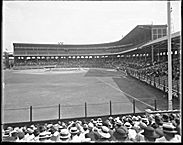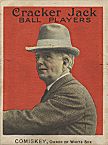| Entries |
| W |
|
White Sox
|

|
Comiskey was a genius at spotting talent. In the World War I era, he created an apparent dynasty by signing established stars like Eddie Collins and “Shoeless Joe” Jackson, as well as new talent like George “Buck” Weaver. Yet Comiskey alienated many players with his tightfisted, petty behavior. He kept their salaries low, deducted World Series bonuses from their paychecks, and even required them to launder their own uniforms. In 1919, player resentment boiled over. When the White Sox lost the World Series to the underdog Cincinnati Reds, rumors surfaced that several Sox players had taken bribes from gamblers to “throw” the games. In the end, eight players—including Jackson, pitcher Ed Cicotte, first baseman “Chick” Gandil, and shortstop “Swede” Risberg—were banned permanently from organized baseball.

|
Although the White Sox contended for the pennant in 1964 and 1967, lean years lay ahead. Veeck gutted the farm system and traded away talented young prospects. Attendance plummeted; poor play was compounded by fears that the neighborhood surrounding Comiskey Park was no longer “safe.” Veeck responded with typical showmanship, hiring “witches” to change the team's luck and outfitting his players in hideous softball uniforms. Even popular announcer Harry Caray departed the White Sox for the Cubs in 1982.
The 1980s opened with a ray of hope. Veeck and his partners sold the White Sox to Jerry Reinsdorf, a real-estate developer who owned the Chicago Bulls, and Eddie Einhorn, a television sports producer who had once sold hot dogs at Comiskey Park. Stocking the team with solid veterans like Carlton Fisk and Greg Luzinski, the new owners brought a division title to Chicago in 1983. But the erosion of fan support and media coverage continued, leading to fears that Reinsdorf and Einhorn would move the White Sox to another city. In response, the Illinois legislature provided funding for a new ballpark. The new park opened in 1991 across the street from the old stadium, which was demolished in favor of a parking lot.
The Encyclopedia of Chicago © 2004 The Newberry Library. All Rights Reserved. Portions are copyrighted by other institutions and individuals. Additional information on copyright and permissions.